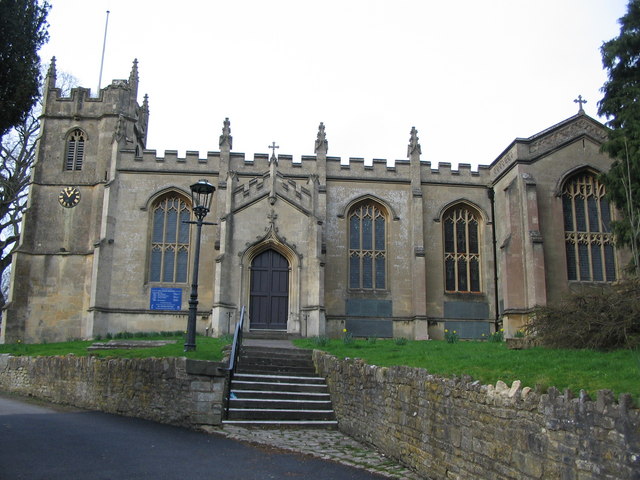- All Saints' Church, Weston
Infobox Historic building

caption=
name= All Saints
location_town=Weston , Bath
location_country=England
architect=John Pinch the Elder
client=
engineer=
construction_start_date=15th Century
completion_date=1832
date_demolished=
cost=?
structural_system=
style=Victorian architecture All Saints' Church is a
Church of England parish church which has been located on a hill at the centre of Weston, a small village on the outskirts of Bath,England , for a thousand years. The current Gothic church was designed by architect John Pinch the Elder and completed in 1832, although it maintains a 15th Century tower for its predecessor “All Hallows” Church. [cite web | title= Church of All Saints | work=Images of England | url=http://www.imagesofengland.org.uk/search/details.aspx?id=442427 | accessdate=2007-10-24]Churchyard
There are over 90 tablets in the churchyard and many more within the church with some going back to the 12th Century. The church kept excellent records which indicated that most of those buried here had no connection with the town but chose the spot for their final repose because it was an idyllically isolated community far from the smog and congestion of Bath. This popularity lasted for over 200 years. [1]
Medieval Church
An early church is mentioned by
Pope Adrian IV in a 1156 Bull. Jordanus, the first vicar, arrives at Weston in 1297. In the 15th Century, “All Hallows” Church is built but is demolished in 1830 to create a larger space for a growing community with only its original tower surviving. The church bells were recast by Thomas Bilbie of theBilbie family atChew Stoke in 1739, and were repaired and retuned between 1952-1953. [http://www.allsaintsonline.org.uk/aboutus/history.htm]Victorian Church
The new church of “All Saints” was consecrated on
June 2 ,1832 . It shares some similarities with Pinch’s other works atSt. Mary the Virgin, Bathwick andSt. Saviour, Larkhall , although both of those examples were newbuilds and are defined by tall western towers, whereas All Saints is more diminished. New seating with new transepts and a chancel were added between 1880 and 1893, and new “clergy and choir vestries were added in 1909.” The church furnishings and internal program have been remodeled several times since then and recently a restoration was undertaken of the tower. Near the tower door is a 19th century font, and on the West Gallery are displayed William and Mary’s royal coat of arms. [http://www.allsaintsonline.org.uk/aboutus/history.htm]Notable Features
On the south aisle there is the
St Alphege window, which “commemorates the famous saint whom tradition says was born in Weston (St Alphege became the Abbot of Bath Abbey and then Archbishop of Canterbury). Also depicted is Guthram, King of the Danes, submitting to King Alfred and accepting Christianity.”In the south transept, there is a “monument toAlderman Sherston dated 1641. He wasMayor of Bath in 1632.“In a niche in the north wall of the chancel is found the oldest monument in the church from the 12-13th century. This is a stonecoffin lid that was found under the south porch during the rebuilding of the church in 1830.”Other monuments include a 1699 honoringJohn Harrington of Kelston , a monument to “Dr William Oliver (of biscuit fame) whose family owned Weston Manor for many years.” [http://www.allsaintsonline.org.uk/aboutus/history.htm]Pevsner Description of Church“Other than the simple C15 Perp [endicular] w [est] tower, the church was rebuilt in 1830-2 by John Pinch the Younger. E Harbottle of Exeter added the chancel and transecpts in 1893m and Mowbray A. Green a memorial chapel in 1921. Nave and aisles. Tall lancet-like three-light windows with four-centred arches and Perp tracery. Battlemetns and pinnacles. Arcade of tall piers of Perp section carrying four-centred arches. The nave is broad and low with a rear gallery….” [Forsyth, 295] “Plate: Chalice and Cover 1572; Apostle Spoon 1614; Chalice and Paten 1692; Flagon 1739. ” [Pevsner, 334]
References
Further reading
*Nikolaus Pevsner, "The Buildings of England: North Somerset and Bristol," (Harmondsworth, Middlesex: Penguin Books, 1958), 334.
*Michael Forsyth, "Bath" (New Haven: Yale University Press, 2003), 295.External links
* [http://www.allsaintsonline.org.uk/| All Saints Church]
* [http://bathdailyphoto.wordpress.com/2007/03/11/070309weston-all-saints-pevsner-architectural-church-chat/| West Facade Photo]
Wikimedia Foundation. 2010.
